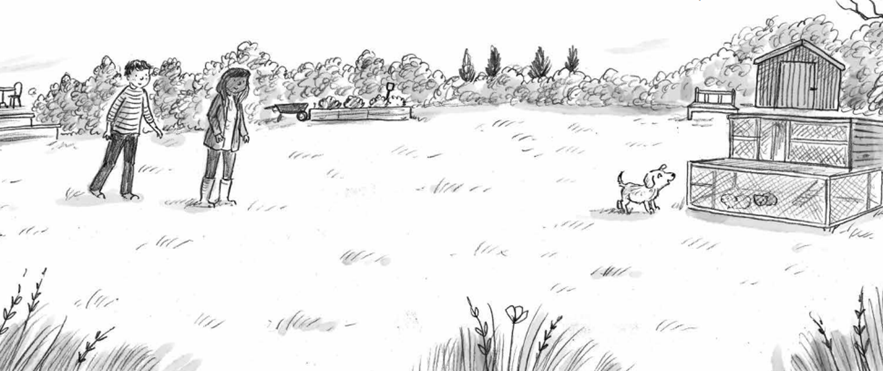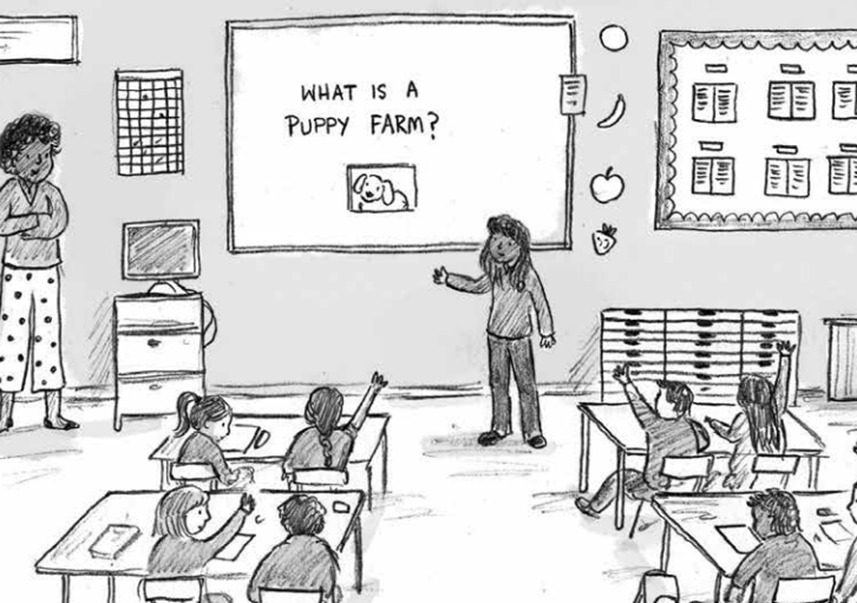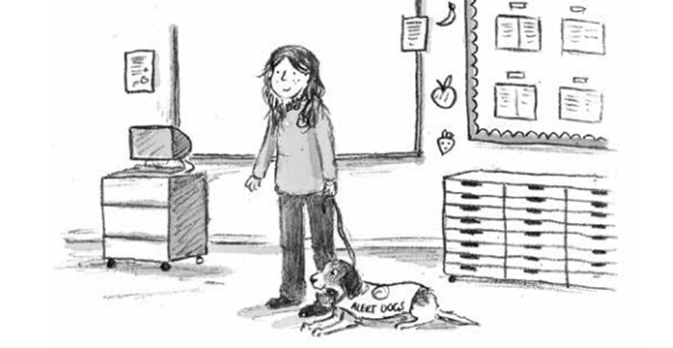Helen Peters introduces A Puppy Called Sparkle
Posted on Monday, November 1, 2021
Category: Author Videos
Any child who loves animals will adore the Jasmine Green series about a girl growing up on a farm, surrounded by pets and animals. But the stories also come with adventure and with themes about looking after animals, training pets and how to make sure that animals are well treated.
A Puppy Called Sparkle (Nosy Crow Books)
Author Helen Peters introduces her new book, A Puppy Called Sparkle - the 12th book in the Jasmine Green animal rescue stories, and tells us some of the themes in the book. She also gives a short reading from an exciting moment in the story in this video.
Download a chapter from A Puppy Called Sparkle
Reviews: "I was expecting a sweet story about Sparkle and her new family. What I discovered was a cleverly written story introducing children to what is involved in looking after a puppy, how to choose a puppy to buy, and to be wary of puppy farms, in child friendly terms."
Q&A with Helen Peters
1. How did you become an author and do you do other kinds of work?
I didn't become an author until I was in my forties. Before that I was a secondary English and Drama teacher, and I still teach part-time. I wrote a lot as a child and a teenager, mainly plays which my friends and I performed in our shed theatre. I did a bit of writing in my twenties and thirties, mostly attempts at short stories and journalism. I entered a couple of competitions, but I didn't really know what I was doing, and I didn't have the confidence to submit anything to an editor.
But when I met my husband and told him about growing up on a farm and making a theatre in a dilapidated shed, he said, "You should turn that into a children's book." That sentence was the lightbulb moment that changed my life. It took ten years to get the book to a publishable state, but I learned so much about writing in those ten years.
2. How does your writing day go, and what are the distractions?
I try to start writing around nine o'clock, once everyone has left the house for work and school. My ideal writing day is reaching my target by lunchtime - a thousand words of a first draft, or whatever portion of a redraft that needs to be done (I make a timetable for redrafts and work backwards from the deadline). Often I don't reach the target, and I go on into the afternoon.
Many things can distract me, ranging from legitimate excuses like family stuff that needs attention, to less noble distractions like Twitter. When the work's going well I'm pretty good at being disciplined, but when I'm stuck or despairing, anything can distract me.
3. You have written several books about animals for young readers - why do you enjoy writing these?
This series has felt like an absolute gift. Weirdly, I had the broad idea for the Jasmine Green series at the exact same time as my editor and publisher had exactly the same idea. My editor pitched the idea to me at a meeting - a nine-year-old girl who lives on a farm, with a vet mother and farmer father, and loves rescuing animals. I loved the idea and on the train home I opened my notebook to start planning the series. And there were my notes outlining EXACTLY the same idea, that I'd written on another train journey a couple of weeks earlier and then forgotten about. So bizarre!
I love writing the books because I love the family I created - they all feel utterly real to me. And I love that I can write about a completely different animal in each story, so I get to research that animal and find out all sorts of amazing facts and read lots of wonderful real-life rescue and rehabilitation stories as part of my research. I also love working with my brilliant editors and seeing the wonderful illustrations by Ellie Snowdon, who seems to know the farm I grew up on as well as I do, even though she's never seen it.

4. Did you grow up with lots of pets, or animals to look after?
My first pets were orphaned lambs that needed bottle-feeding, and I loved that moment every spring where I was given a lamb to look after. I also had a lovely rabbit called Bobby, and a wonderful tortoiseshell cat who had kittens every year. The kittens were always gorgeous, and we had no trouble finding homes for them. I'm sure there are many of Noddy's descendants still living all over Sussex!
I now have two beautiful cats called Boris and Inka, who came with our house. The owners were moving abroad and couldn't take them, so we offered to keep them.
5. Are any of the animals in your stories based on the pets you have had or animals you have known?
Yes, lots of them! My sister was the real animal rescuer and collector in the family, and she later became a veterinary nurse, so then she had access to even more animals that needed re-homing. She really did have a huge pet sheep called Jasper, who had a duck friend called Lucy who used to ride around on his back. I used their names and characters in The Secret Hen House Theatre.
The collie in A Sheepdog Called Sky was based on an abandoned collie that my sister rehomed. My brother kept goats and my grandad had donkeys, so they inspired A Goat Called Willow and A Donkey Called Mistletoe. My own cats inspired Jasmine's two cats, and I used the name and personality of my cat, Inka, in Anna at War.
6. Would you have loved a childhood like your character Jasmine's, whose mum is a vet and who ends up rescuing lots of animals in these stories?
I actually had a very similar childhood to Jasmine's. My dad is a farmer and was happy for us to keep as many animals as we wanted (though, like Jasmine's dad, he drew the line at horses), and luckily there was plenty of space for them. My siblings and I had the freedom to spend all our time roaming the farm and the woods, and we were constantly creating secret clubs in sheds, building dens in the woods, and trying to make rafts that would sail on the pond (they always sank).
7. Can you tell us a little about your latest book, A Puppy Called Sparkle, and what inspired the idea?
A Puppy Called Sparkle begins with Jasmine and her mum stumbling across a puppy being handed over to a new owner at a service station. Jasmine is concerned about the puppy's health, and alerts her mum, who immediately recognises that the puppy comes from a puppy farm. They interrupt the sale and rescue the puppy, and Jasmine is allowed to look after her until they find her a permanent home. Inspired by a talk by another girl in her class, Jasmine starts to plan a future for Sparkle as an assistance dog. But then puppy thieves appear in the village, and suddenly Sparkle is in great danger.

8. Do you enjoy exploring different themes in each of these books?
I do enjoy exploring different themes in each book. It's partly a deliberate choice, to make each story different from the others in the series, and it partly comes as a result of the research into that particular animal.
A Puppy Called Sparkle was directly influenced by Covid, although the story isn't set in the pandemic. I had the first idea for the story at the beginning of the pandemic, when I heard a representative from Medical Detection Dogs appealing on the radio for people with Covid to send their dirty socks to the charity, so that the detection dogs in training could learn to detect the scent of the virus.
The other strands in the story, about puppy farms and puppy theft, were influenced by the news reports about these crimes since the beginning of the pandemic, following the huge rise in demand for puppies. Puppy farming is a horrible business, and puppy farmers are becoming cleverer at hiding what they do, so I really wanted to include some of the warning signs to look out for when families are choosing a puppy.

9. There are also lots of tips in the story about training puppies - where did you go to research these and why did you want to include them?
I did most of my research online. Charities like the PDSA have excellent puppy-training videos and tips on their website, and there's a huge wealth of helpful dog-training information online.
I always try to make my stories as factually accurate as possible, and I've had lots of feedback from children who say they enjoy learning about animal care from the books. I love learning about animal behaviour, care and training, and if I find a particular fact interesting, I hope that readers will, too.
It's a struggle not to put in too much, though - my first drafts are always too long, and I end up having to cut out a lot of the facts I've researched!
10. How did you find out about assistance dogs, and why did you want to include that in the story?
I've always found assistance dogs amazing, so it was a joy to research that part of the story. Again, I did a lot of the research from assistance dog charities' websites and videos. I also attended a webinar hosted by Support Dogs, talking about the work their incredible dogs do with people living with conditions such as epilepsy. Some of the support dogs and their human partners were present at the webinar, and it was wonderful to see and hear from them.

11. Do you enjoy seeing the illustrations by Ellie Snowdon for each book?
I love it! Ellie's work is so beautiful, and I know she will bring each animal to life in the most wonderful way with her illustrations. I so look forward to seeing what she's done with each story, and the illustrations make me so happy. I'm incredibly lucky to have Ellie illustrating this series; her work enhances the stories so much.
12. Do you have more stories planned in this series?
I do! I've just written the first draft of A Seal Pup Called Pearl, which should be published next summer. It's inspired by my brother's extraordinary sighting of a harbour seal relaxing on a fallen tree trunk in the river that runs through his farm. It was such a surreal sight when I saw his photos, and once I'd got over the surprise, I sent the pictures straight to my editor and suggested a seal book. Luckily, she loved the idea!
13. Can you describe your ideal writers' shed, and where it would be?
A: This is something I think about a lot! Whenever I visit a stately home with a beautiful summerhouse in the garden, I redecorate it in my imagination as my writing shed.
So my ideal writing shed wouldn't really be a shed at all, but a grand summerhouse with brick walls, tiled floors and a high ceiling. All along the front wall would be floor-to-ceiling French windows, and the other walls would be lined with books. I would have a big table facing the windows, and a fireplace in one wall, so I could keep cosy with a log fire in the winter.
The summerhouse would be in a garden full of flowers and fruit trees and singing birds, and all around the garden would be woods and hills. The garden would be walled on three sides, but at the front it would open out on to a lake. When I needed a break from writing, I would swim in the lake or walk in the woods and hills.
14. What do you to relax when you're away from your desk?
Like most writers, it seems, I love reading and walking (though not usually at the same time). I'm lucky enough to live between the South Downs and the sea, so most days I go for an afternoon walk across the Downs and back along the seashore. The landscape is different every day with the changing light and weather, and the sky can be incredibly dramatic.
I also love reading, of course. I like to vary my reading diet with a mixture of children's books, adult fiction, memoir and history. I love reading diaries, both real and fictional. One day I'd like to write a book in diary form.
